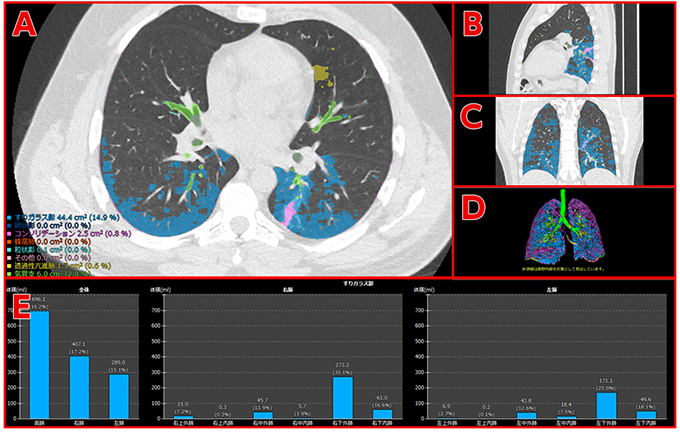
(Under development) CT images of a patient who has developed pneumonia as a complication of COVID-19 and analysis results A: CT image’s axial view (transverse plane), B: Sagittal view (longitudinal plane) C: Coronal view (vertical plane into ventral and dorsal, D: 3D image, each showing the results of lesion identification E: Graphs showing the presence of a specified type of lesions by zone and its volume
Fujifilm to Develop AI-based Technology to Aid COVID-19-Induced Pneumonia Diagnosis and Assess The Effectiveness of Treatments
Company commences joint research study with leading medical institutions in Japan, applying lesion quantification technology for pneumonia
TOKYO, May 19, 2020 — FUJIFILM Corporation (President: Kenji Sukeno) is commencing a research study to develop Artificial Intelligence (AI)-based technology to aid in the diagnosis and treatment assessment of patients with COVID-19-induced pneumonia. The technology for quantifying the lesions of interstitial pneumonia*, co-developed with Kyoto University (the Department of Respiratory Medicine, Graduate School of Medicine, Professor Toyohiro Hirai), will be applied to the project. The company will now embark on a joint research study with local medical institutions treating COVID-19 patients, starting with the Kanagawa Cardiovascular and Respiratory Center (Yokohama, Japan).
The spread of the novel coronavirus, which causes COVID-19, has emerged as a serious issue around the world. The world has yet to see clear judging criteria for determining the effectiveness of various treatment options, currently explored by doctors. In order to confirm the progression of pneumonia and the effectiveness of treatments, doctors need to examine hundreds of chest CT images for each patient to visually check the characteristics of ever-changing lesions and it puts a serious strain on specialists. There are expert opinions that COVID-19-induced pneumonia presents similarly to interstitial pneumonia in diagnostic images and has diverse variations in lesion patterns. Fujifilm’s CT quantification technology for interstitial pneumonia is powered by an AI-based software that examines CT images to identify bronchi, blood vessels and normal lungs in lung field** as well as seven types of lesions such as reticular opacities, ground-glass opacities and honeycomb lungs***, and automatically carries out categorization and measurement to quantify lesions of interstitial pneumonia. It also divides the lung field into 12 zones*4 and shows the volume and ratio of lesions for each of the zones so that clinicians can examine the distribution and progression of lesions within the lung field in details.
Fujifilm began collaborating with Kyoto University in the spring of 2018 and applied Fujifilm’s AI technology to categorize and quantify lesions of interstitial pneumonia to case data held by Kyoto University. The cycle of evaluating its identification performance and providing feedback for improvement was repeated numerous times for enhancement, resulting in an advanced level of precision in lesion type identification.
Fujifilm will apply this CT quantification technology for interstitial pneumonia to develop the technology that helps evaluate the progress of patients with COVID-19-induced pneumonia and determine the effectiveness of treatments. In addition, the technology is expected to contribute to accelerating the development and evaluation of drug candidates for treating pneumonia induced by COVID-19.
Fujifilm has been working on developing AI technology that can be used for assisting medical diagnostic imaging, facilitating workflow at the medical frontline and delivering maintenance services for medical equipment. The company’s AI technology for use in these domains is now marketed under the brand name, “REiLI.” In order to deliver solutions that meet various needs and workflows at the medical frontline, Fujifilm will continue to carry out technological development to achieve fast-paced development of solutions aimed at assisting doctors in diagnostic imaging and streamlining their workflow.
*Interstitial pneumonia is a general term for pulmonary inflammation and fibrosis that result in the hardening of the lungs. The term covers a wide range of conditions including those with clearly-defined cause such as pneumoconiosis (caused by asbestos) and those with no known causes, i.e. idiopathic interstitial pneumonia. Idiopathic pulmonary fibrosis (IPF) is the most common type of idiopathic interstitial pneumonia, and is estimated to have the incidence rate of 2.23 per 100,000 and the prevalence rate of 10.0 per 100,000. (Source: “Hokkaido Study (Natsuizaka M, et al. Am J Respir Crit Care Med 2014; 190: 773-779.)”).
**The lungs themselves that appear dark at the right and left of a frontal chest X-ray
***Congregation of circular shadows that resemble a honeycomb
*4A total of 12 zones obtained when dividing the lung field into left / right, top / center / bottom and inside / outside
(Under development) CT images of a patient who has developed pneumonia as a complication of COVID-19 and analysis results
A: CT image’s axial view (transverse plane), B: Sagittal view (longitudinal plane)
C: Coronal view (vertical plane into ventral and dorsal, D: 3D image, each showing the results of lesion identification
E: Graphs showing the presence of a specified type of lesions by zone and its volume
Other Avigan/COVID-19 Coverage ( 1, 2, 3, 4, 5, 6, 7, 8, 9, 10. 11, 12, 13, 14)
Please don’t forget to follow us on Facebook, Twitter, Instagram, YouTube
Plus our owners’ groups
Fujifilm GFX Owners Group
Fujifilm X-H Owners Group
Fujifilm X-T Owners Group
Fujifilm X-Pro Owners Group
Fujifilm X-E Owners Group
Fujifilm X-A Owners Group
Fujifilm X100 Owners Group
